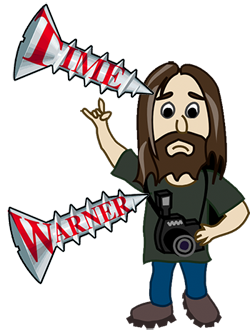FocalPop - Expect Pop Pop Fizzle Out
 Who grades these grad school fantasies, Krusty the Klown? FocalPop - the latest incarnation of the idiocy of crowd-sourcing advertising photography assignments has apparently ozzed from the hot Summer nights of UT Austin. Here's the pitch:
Who grades these grad school fantasies, Krusty the Klown? FocalPop - the latest incarnation of the idiocy of crowd-sourcing advertising photography assignments has apparently ozzed from the hot Summer nights of UT Austin. Here's the pitch:
1. Seekers fill out a request describing the exact photo they need, how much they'll pay, and how soon they need it.What's missing: Oh, right - buyers don't get to dictate price.
2. FocalPop notifies the community of Photographers of the new Photo Request.So far, all 10 of their requests (here) have come from one of the company founders, several of which were used to illustrate the website itself.What's missing: Oh, right - qualifications to actually do it. "The proof is in the pudding" doesn't work too well here.3. Photographers review Request details, shoot photos that meet the Request needs, and upload submissions for review.What's missing: the best results come from a dialog with the client, and who's covering the expenses for the shoot? Oh, wait, maybe that's the photographer.4. After the deadline, the Seeker reviews all of the photos submitted, selects their favorite, and pays FocalPop the amount they specified in the Request.What's missing: What if they don't like any? Unlike other plans, FocalPop will select the winning photographer and pay them from escrowed funds supposedly set aside by the client (a.k.a. "Seeker"). According to their T&C - "The Seeker further agrees that it would be unfair if no photographer received the award(s) offered by the Seeker due to the Seeker abandoning the request. Therefore, if the Seeker does not select the winning design/photographer(s) within seven days after their request ends, the Seeker agrees that FocalPop may select the winning photographer(s) and pay the award(s) on behalf of the Seeker. Additionally, you agree that when you are a Seeker in a request, you will complete wrap-up in your request within thirty (30) days after your request ends. You authorize us to release escrowed funds to pay the winning photographer(s) if more than thirty (30) days have passed since your request ended." Interesting, so let me get this straight - the client has to blindly agree to accept whatever images are produced by an unknown quantity/quality of photographers? Oh no, wait - their Seeker FAQ doesn't quite agree with the T&C above "We take a deposit of 30% at the time a Request is created in order to protect the photographers. We want to ensure no one requests photos that they don’t actually intend to purchase. However, if your Request receives less than 15 submissions and you are not happy with the results, we will gladly refund the 30% deposit – no questions asked."5. FocalPop provides the high resolution file to the Seeker and pays the winning Photographer a commission on the sale.What's missing: Hmmm, let's see - FocalPop would be the one recieving a "commission" on the sale, as the conduit. According to their T&C here, they'll take 30% to serve as this conduit. Or, wait - is this the same 30% that the photographer gets if a winner isn't chosen? Hmm, then maybe FocalPop takes 70%?
So, who are these dreamers? Brian Romanko (LinkedIn: Profile) touts in his biographical sketch about his past - "...Brian worked for numerous startups — both successful and utter failures..." Brian - be glad you got a good grade on this, because the real world has already proven this crowd-sourcing school project of yours to be an utter failure - see Pixish - Stupid Is, As Stupid Does (2/12/08) and Pixish - Finally Down The Tubes (2/7/09), and even the lunacy of David "that model was interesting, but didn't pan out" Norris (7/12/07, OnRequest - Realizing the Obvious). Heck, even Brian's friend Jonathan Cho (LinkedIn: Profile) trashes the idea here "...in the spirit of hating on crowdsourcing, here’s a similar site that my friend’s launching, except instead of design its photography: http://www.focalpop.com/ ...as a fucking awesome designer, i’m a bit ashamed to admit that i’ve submitted a few designs to crowdspring. an hour or two in illustrator = quick buck, right? what’s horrible is that my designs have never been picked. i’ve always lost to much crappier designs. and that is why i hate crowdspring." With friends like that...oh, wait - his friend is actually smart and giving him good advice.
Co-Founder Becky Parker (LinkedIn: Profile) seems to be simultaneously tasked to "Oversee the strategic planning for Sony Electronics' online social marketing programs" at marketing firm Powered, Inc, as well as trying to "...find her passion for offering true value to customers online and in developing meaningful customer relationships" for FocalPop. Becky - try working to find value for the creative talent that will produce this work, not pennies on the dollars of what the projects should really be worth. Hint: A project you facilitate for $100 that earns you $30 for FocalPop really could earn you $300 if it was more appropriately priced at $1,000. I guess, though, that winning the Moot Corp contest taught you to over-value moot money? Tip: moot money is as valuable as monopoly money in the real world.
The third in the trio of wunderkinds is Shawn Carr (LinkedIn:Profile), wooed in by the void left by Ronnie Lebert (LinkedIn: Profile), Eddie Howard (LinkedIn: Profile), who have both left for smarter options at Dell and Datran media respectively. Carr hasn't left the chilly weather of New England where he is an IT manager for a small company, and consulting for Croop-LaFrance. Hint - don't quit your day job, Pixish and OnRequest, as detailed above, are your harbingers of things to come, and that equity you might have - not going to be worth much, just make sure you get paid before you have to post that "out of business" splash page.
FocalPop is the quintessential example of the re-hashed ideas coming from MBAs time and time again. This idea hasn't worked before, and it won't work this time.
Please post your comments by clicking the link below. If you've got questions, please pose them in our Photo Business Forum Flickr Group Discussion Threads.





